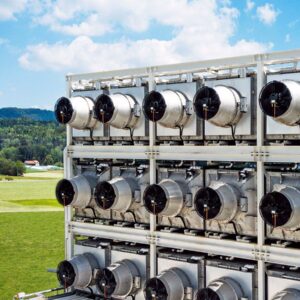The recent extreme weather events are no longer anomalies. They illustrate the disturbing, long-term reality of climate change and the need for the United States to adopt a comprehensive strategy to cut its greenhouse gas emissions before it is too late. Our climate is like a ship caught in the middle of a storm, where persistent rain and relentless waves are pouring more and more water into the hull. To save our ship, we must use every means available to bail the water overboard. In other words, we need every available technology and each sector of our economy to decarbonize as soon as possible.
For some, like the power and transportation sectors, there’s a linear pathway. They must retire their fossil fuel power plants and replace them with renewables — and then electrify cars and trucks to run on that clean energy. But others — like industrial manufacturing, agriculture, and aviation — have a less certain decarbonization pathway because there are few mature zero-emission technologies ready to be deployed, and it may take decades (which we don’t have) to fully implement them.
So, how do we keep the ship afloat long enough to make it safely through the storm? One solution lies in Carbon Dioxide Removal (CDR) technologies that can remove CO2 directly from the atmosphere. CDR not only addresses historical emissions but also counterbalances those hard-to-decarbonize industries as they find a way to reach net zero.
Companies like Charm Industrial, Climeworks, and Heirloom are already developing and deploying CDR technologies with a diverse roster of clients and partners. They remove CO2 from the atmosphere by sequestering carbon in bio-oil derived from agricultural waste, deploying direct air capture to filter CO2 from ambient air, and helping minerals absorb CO2 from the air at an accelerated rate. These technologies are the beginning of a vibrant and critical carbon removal industry, which has already created customer partnerships with major companies like Microsoft, Shopify, and Stripe. Despite this strong start, however, we need more companies and entrepreneurs to get involved — and we need the federal government’s help to achieve this.
Just as federal efforts are necessary to speed up the deployment of renewable energy and the electrification of transportation, CDR businesses will need similar levels of federal investment to scale up, in order to reverse the accumulating CO2 in the atmosphere. We are certain that when properly incentivized, CDR can be both a major climate solution for residual carbon emissions and a major job creator.
The good news is policymakers have already started down the path of incentivizing carbon capture, utilization, and storage (CCUS) at point sources of emissions — like fossil fuel power plants and other industrial facilities — through the 45Q tax credit. The bad news is that in 45Q’s current form, it prioritizes the prevention of new emissions and does far too little to address the carbon already in the atmosphere — water already in the hull. To be a true launchpad for the CDR sector, 45Q must be expanded to include many kinds of innovative CDR solutions in addition to Direct Air Capture, which is already eligible. It must support these technologies earlier by lowering the eligibility threshold so they can mature faster, offer an option for direct payment (preventing the loss of value through the tax equity market), and increase the sequestration credit to $180/ton.
These changes will lead the U.S. to see explosive growth in the CDR sector and dramatic reductions in the cost of decarbonization. This can be further accelerated if the federal government purchases early-stage carbon removal to address its own residual emissions from its sprawling agency buildings, transportation requirements, and global footprint, as envisioned in the bipartisan infrastructure package as part of the proposal to establish regional DAC hubs. In doing so, it would also play a key role in scaling CDR by being a first buyer, which will draw in other customers and provide critical stability for CDR companies.
If we want to reach the carbon removal scale necessary to make a real difference with climate change, it’s critical that the federal government increase CDR incentives and leverage its substantial procurement power to accelerate innovation and commercialization.
The upcoming reconciliation package is a good place to start as climate, jobs, and long-term innovation are core themes. If Congress is successful in passing these meaningful CDR policies, it will ensure we have bigger, better, and more plentiful means to remove water from the hull, save our ship, and keep us afloat for generations to come.

